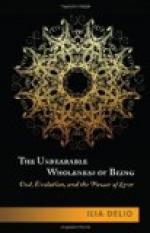Ornamentation and capitals, previously a combination of geometrical figures, which may have been architecturally great and imposing, but was always more or less formal and rigid, disappeared; the new masters, whose names have been forgotten, looked round them and drew inspiration from nature. The forest trees of Central Europe became pillars; grouped together, apparently haphazard, they reflected a mystical nature pulsing with mysterious life. Spreading and ramifying, growing together in an impenetrable network of foliage, they bore buds, leaves and fruits. Every pinnacle became a sprig, even the pendant icicles reappeared in the gable-boards. But the assimilation of natural objects did not cease there; tiny animals, light as a feather, run over the tendrils, lizards, birds, even the gnomes of German mythology, find their way into the Gothic cathedral. Not the traditional Greek acanthus leaf, but the foliage of the North-European oak grows under the hands of the sculptor. Even the cross is twisted into a flower; the sacro-sanct symbol of the Christian religion is newly conceived, newly interpreted and moulded so that it may have a place. The Gothic cathedral with its soaring arches free from all heaviness is the perfect expression of that cosmic feeling that inspired Eckhart and reached its artistic perfection in Dante.
But the soul of the mystic in stone contains the same elements as the soul of Eckhart, who was also a schoolman. The confused and complex scholastic world of ideas which corresponded so well with the mediaeval temper and, together with the new art, had emanated from Paris, is closely akin to Gothic architecture. For the Gothic style and scholastic thought share the characteristics of the infinitely constructive and infinitely cleft, the infinitely subtle and ornamental—perhaps the last trace of the spirit of the north as compared with the simplicity of the south.
As if from fertile soil, a world of sculptured men and beasts sprang from the facades of the new cathedrals. The figures on the cathedrals of Naumburg, Strassburg, Rheims, Amiens and Chartres are far superior to the artistic achievements of the dawning renascence in Italy. They are real men, full of life and passion, no longer symbols of the transcendental glory of the world beyond the grave. “All rigidity had melted, everything which had been stiff and hard had become supple; the emotion of the soul flows through every curve and line; the set faces of the statues are illuminated by a smile which seems to come from within, the afterglow of inward bliss” (Worringer).
A longing went through the world, stimulating faith in miracles and a desire for adventure, a longing which no soul could resist. Nothing certain was known of countries fifty miles distant; the traveller must be prepared for the most amazing events. No one knew what fate awaited him behind yonder blue mountains. The existence of natural laws was undreamt of; there was no improbability in dragons




